
 |
MORDANTS
Scouring
Scouring is the first step in the preparation of dyeing wool. Every 10 kg (22 lbs) of wool requires 365 litres (80 gallons) of water, to which soap is added and stirred while it is heated to simmering temperature. The wool is immersed in the simmering water for forty-five minutes. It is then removed, cooled and rinsed until all the soap has gone, strained of the excess water and mordanted straight away, or else - left to dry.
Mordants
Dyestuffs are
soluble in water, but pigments are not, as they consist of organic matter.
Mordants (from the Latin mordere, to bite) are metallic or mineral salts
which, when added to the natural dye bath either enhance, intensify, or change
the colour. They also play a large role in making the resulting shade faster to
light and washing. The shade will vary depending on the mordant used.
Alum
(potassium aluminum sulphate) is the most widely used mordant for dyeing with
natural dyes. Copper sulphate (blue vitron), iron or
ferrous sulphate (copperas), tannin (tannic acid), tin (stannous chloride) and
chrome (potassium dichromate) are also
used.
| Alum - Adds brightness and fixes the colour - Most commonly used pre-mordant (generally all wool is pre-mordanted with Alum) - The use of too much will leave the fibre feeling "sticky" and harsh - The use of cream of tartar with alum is recommended as it softens the effects of alum and helps with evenness - Alum mordanted wool can be stored - Requires approximately 120-180 gms for 1kg of wool and silk |
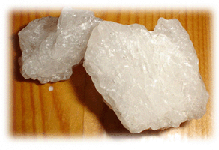 Alum (potassium aluminum sulphate) |
| Iron (iron or
ferrous sulphate) - Will sadden or darken colours - Too much will harden fibre and cause colours to streak - Generally fibre is dyed before mordanting - Is a good idea to always use separate pot for ferrous sulphate, as even a small amount of residue will darken subsequent dyebath - 2-4 tablespoons for 1kg of wool |
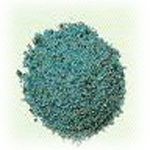 Iron or ferrous sulphate |
| Copper (Copper sulphate)
- Brings out greens from
yellows |
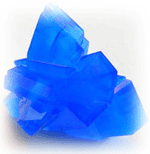 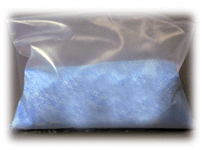 Copper sulphate- crystal (left) and powdered |
| Tin - Popular as it produces the most dramatic shades - Brightens and enhances colours, especially reds, oranges and yellows - Can be used to pre-mordant fibre, though generally added to dyebath - Needs to be used sparingly, a little goes a long way - Mostly used with cream of tartar - 2-4 teaspoons for 1kg of wool, 4 teaspoons of cream of tartar - Using more than 5 teaspoons of tin will make fibre very harsh and tender - Using more will than 8 teaspoons will carbonise wool - Can spoil felting properties of wool |
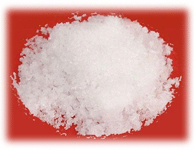 Tin (stannous chloride) |
| Tannin and
tannic acid - Good mordant if tans or browns are required - Gives dark shades - Wool pre-mordanted with tannic acid tends to darken with age - Cutch, Myrobalan, Pomegranate, Quebracho, the bark of oak, hemlock, chestnut, the leaves of certain sumacs and plant galls, tea, coffee and walnuts have high concentrations of tannic acid therefore can be used as a substitute |
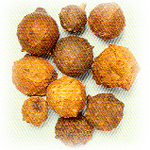 Tannin |
| Chrome
(potassium dichromate) - Gives a browny tint to the colour - As this substance could be hazardous to health, we rejected to use it as a mordant. Generally it does brighten colors. |
.gif) Chrome (potassium dichromate) |
Alum: The word "alumen," which we translate "alum," occurs in Pliny's Natural History. Alum was imported into England mainly from the Middle East, and, from the late 15th Century onwards, the Papal States for hundreds of years. Its use there was as a dye-fixer (mordant) for wool (which was one of England's primary industries), the value of which increased significantly if dyed. These sources were unreliable, however, and there was a push to develop a source in England. With state financing, attempts were made throughout the 16th Century, but without success until early on in the 17th Century. An industry was founded in Yorkshire to process the shale which contained the key ingredient, aluminium sulfate, and made an important contribution to the Industrial Revolution. Alum (Known as turti in local Indian languages) was also used for water treatment by Indians for hundreds of years.
Tannin (Tannins: derived from ancient Celtic word tan for oak), tannic acid, or gallotannic acid - astringent vegetable product found in a wide variety of plants, especially those containing perennials. Major sources of tannins today:
Wattle bark Acacia decurrens and other Acacia spp. Cultivated in plantations in the dry, mediterranean regions of southern Africa and Australia.
Quebracho Schinopsis lorentzii and S. balansae (Anacardiaceae) Harvested from wild plants in Chaco region of northern Argentina, western Paraguay and eastern Bolivia.
Mangrove Bark from red mangrove Rhizophora mangle (Rhizophoraceae) Mangroves coastal estuaries of subtropical and tropical regions. Trees are harvested from wild populations, especially in Indonesia, West Africa, and Central America. Workers cut down trees during low tide from boats, remove bark, and ship to processing plants where it is air dried, pulverized. Least expensive tannin. Used extensively in shoe and industrial leather industry.
Sources include the bark of oak, hemlock, chestnut, the leaves of
certain sumacs and plant galls. Tannin is also present in tea, coffee, and
walnuts.
A solution of tannic acid is obtained from one of above mentioned natural
sources by extraction with hot water; in particular, gallotannic acid is
obtained from plant gall. Tannin varies somewhat in composition, having the
approximate empirical formula C76H52O46. Tannic acid is a colorless to pale
yellow solid; it is believed to be a glucoside in which each of the five
hydroxyl groups of the glucose molecule is esterified with a molecule of
digallic acid.
Tannin is used in tanning animal skins to make leather; it
transforms certain proteins of animal tissue into compounds that resist
decomposition. It is also used in manufacturing ink and in medicine as an
astringent and for treatment of burns, besides as a mordant in dyeing.
History: The
use of tannins to cure leather dates back at least 3000 years. 3300 year old
leather sandals found in Egyptian excavation sites. Tanyards, which are areas
where leather curing takes place, found in ancient Roman sites tannins derived
from sumac, Rhus spp. (Anacardiaceae) and oak, Quercus spp. (Fagaceae).
Other European sources for tannin include spruce, Picea spp. (Pinaceae)
and pomegranate, Punica granatum (Puniceae). Early European settlers in
North America learn to extract tannins of hemlock, Tsuga candensis (Pinaceae)
from Native Americans. Booming tanning industry develops in Boston during 1700s
and 1800s with tannins extracted from hemlocks of the Adirondacks (NE NY).
However, by 1880s, hemlock supply is allegedly exhausted. Industry turns to
chestnut, Castanea dentata (Fagaceae) and moves to Pennsylvania where
oak-chestnut forest is centered. But with chestnut blight, which wiped out
chestnut tree populations by 1930s, US now imports most of its tannins.
| No mordant | Alum | Copper sulphate | Ferrous sulphate | Tin | |
| MADDER | Pink tan-Red-Brownish Red | Deep orange | Dark tan | Brown | Orange |
| EUPHORBIA | - | Yellows | - | - | - |
| INDIGO | Blue |
- |
- |
- |
- |
| COCHINEAL | Pinks/magentas | Crimson | Dusty purple | Grey/purple | Red |
|
POMEGRANATE |
- | Yellow/brownish | - | Khaki/grey | - |
Mordanting
Pre-Dyeing: This is done before dyeing. It results in even dyeing and fibres are quite fast to light and washing. One kilo (2 lb) of dry wool requires 27 litres (6 gallons) of water. The mordant is placed in warm water and stirred until dissolved, The wool is added and simmered for one hour, and then cooled, rinsed, dyed or dried. Clearer colours are obtained by mordanting before dying.
While
Dyeing: Proportions are as above. The mordant is either dissolved in the
dyebath or separately and added. The wet, scoured wool is immersed and simmered
for thirty minutes. Then 285 g (10 oz) of tartaric acid and a generous cup of
dye salts are dissolved in 1.25 litres (2 ¼ pints) of water and added to the
dyebath. These facilitate the action of the mordant. The wool is simmered for
another half hour, cooled in the liquid, thoroughly rinsed and hung out to dyr.
It is less trouble to mordant while dyeing, but the colour may not be as good.
Post-Dyeing: The process of mordanting pre-dyeing is followed. The wool
is then dyed, rinsed, and returned to the original mordant solution, simmered
for thirty minutes, removed, rinsed and dried. This fixes the colour. If a
different tone of colour is required, half the original amount of mordant to
fresh water is dissolved, the wool added and simmered for thirty minutes or
until the desired change has occurred, then it is removed, rinsed and dried.
Colour Run: If a colour bleeds into another, it means that the dye has
not been properly fixed, or mordanted. Colour run may also be caused by a
less-than-thorough rinsing of the wool after dyeing, so that an excess of dye is
left. There are few successful chemical recipes for removing colour run. The
best solution is to leave the kilim exposed to sunlight over a period of time,
although the sun-bleaching process will also fade the fast colours. A
preparation of seven parts natural yoghurt and one part commercial colour
remover can also yield reasonable results. Bleach is effective on cotton, but
turns wool yellow.
Mordanting
recipes
Alum: For 1 kilo of wool, 180g (6 oz) of alum in 27 litres (6 gallons) of
water is mixed and stirred until dissolved. The wet, scoured wool is added, and
simmered for one hour. When it has been cooled and rinsed, the wool is ready for
dyeing.
Copper Sulphate: 115 g (4 oz) is sufficient for one kilo of wool. This is
simmered for an hour, or less if lighter tones are needed. If very dark colours
are required, the amount of mordant is increased. Good for dyeing shades of
green.
Chrome: The process for pre-dyeing is followed. Two heaped tablespoons of
chrome is enough for one kilo of wool. The chrome is dissolved, then the wool is
added, simmered for forty-five minutes, cooled in the liquid and rinsed. The
dyespot should be kept covered, as chrome is sensitive to light and different
tones may result from what is required Likewise, dyed wool is invariably dried
in the shade.
Copperas: 45-60 g (1 1 ½ oz) per one kilo of wool is dissolved before
the wool is immersed and simmered for thirty minutes, 8 ¼ tablespoons tartaric
acid and generous cup of dye salts dissolved beforehand in a litre of water, are
added and simmered for a further thirty minutes. The wool is then cooled in the
liquid and rinsed. Copperas is not recommended to be used a lot, because it is
corrosive.
Tin: One kilo of wool requires 4 ¼ teaspoons tin, dissolved completely in
the dye bath before the wool is immersed. The heat is increased slowly over one
hour to simmering point, and then kept there for one hour; the wool is then
cooled in the liquid and rinsed.
Tannin: Tannin
powder can be bought but we mostly use the natural plant sources indicated
above. 2 heaped tablespoons of the powder or 500 g of bark should be added into
the 5 litres of boiling water and leave wool to soak for 24 hours. If we use
tannic acid then the recipe should be as:
60-65 gram tannic acid (Myrobalan)
1 kg wool
Tannin is a very strong astringent and may be used as an additive with other
mordants.
Copyright © 2004-2017 Azerbaijan Rugs
E-mail:
vd@azerbaijanrugs.com
Tel: +994 50 380 88 78 (Baku, Azerbaijan)